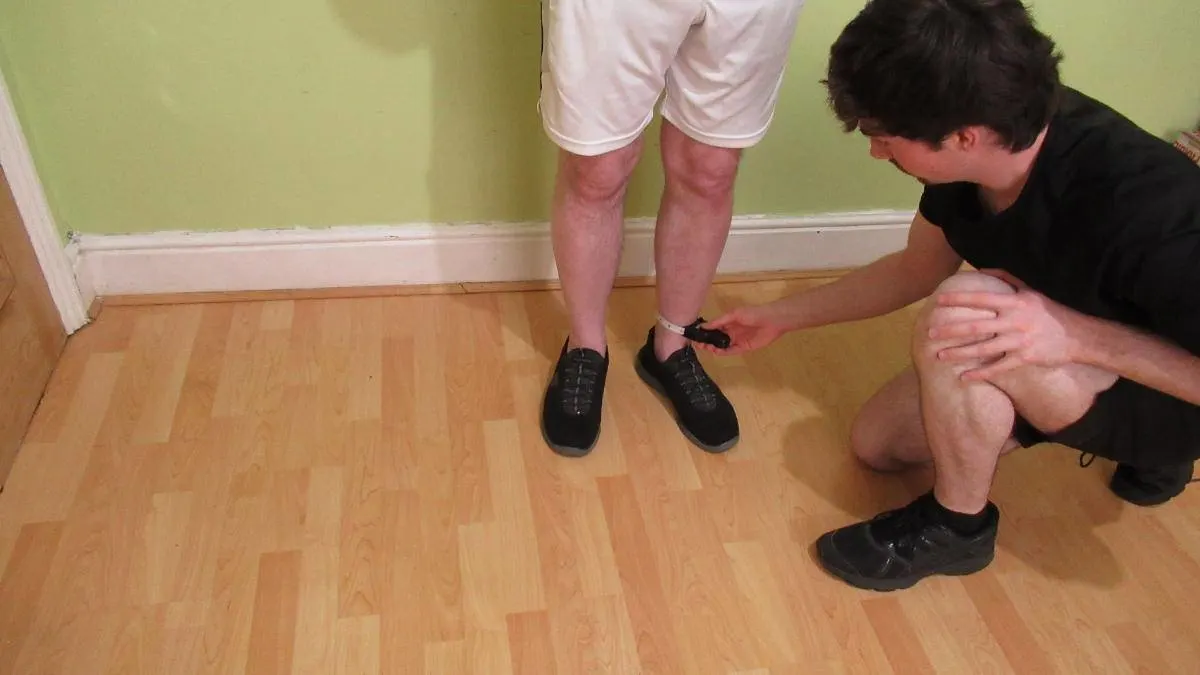If you want to discover the average ankle size for men and women—and learn how to take an accurate ankle measurement—then this is the article for you.
We poured through over a dozen scientific papers and anthropometric datasets to learn everything there is to know about the average ankle circumference in males and females. Here are the results.
Related Measurement Guides:
What is the average ankle size for a woman?
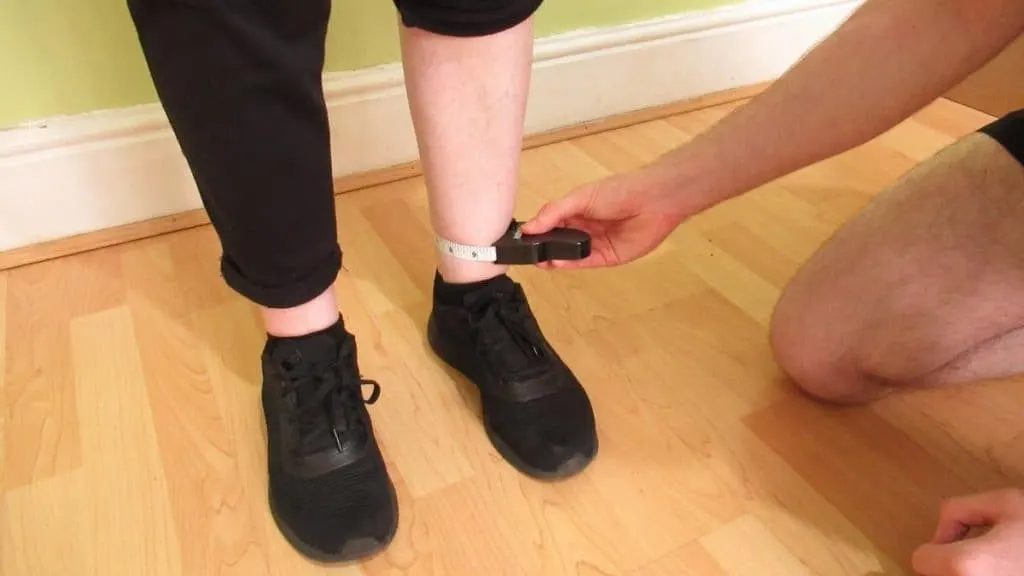
What is the average ankle size for a woman? Based on US anthropometric data taken from a 1988 report that measured the ankles of 2208 women, the average female ankle size is 8.08 inches or 20.53 cm. [1]
While this value is still likely representative of the ideal ankle size for a female (i.e., for a woman who’s enjoying her best health), the data is more than 30 years old at this point.
Considering that both women and men are getting bigger, it’s highly likely that many women have ankles that are thicker than 8 inches.
The trouble is that many research studies use mixed-gender participants, so it can be hard to get specific values for male and female ankle circumference.
For example, a Turkish study of 75 female students and 75 male students found that the average ankle measurement across all participants was 8.94 inches or 22.7 cm. [2]
So, in summary, the average woman’s ankle size is just over 8 inches, a body part measurement that’s especially prone to significant increase when a woman gains body fat.
See How Your Ankles Compare:
- 6 inch ankles
- 7 inch ankles
- 8 inch ankles
- 9 inch ankles
- 10 inch ankles
- 11 inch ankles
- 12 inch ankles
What is the average ankle circumference for males?

What is the average ankle circumference for a man? According to American anthropometric data that measured the ankles of 1774 men, the average male ankle size is 8.73 inches or 22.17 cm.
A similar study that came out around 20 years earlier (in 1966) found that the average male ankle circumference was 9.15 inches. [3] I say similar because both reports examined the body measurements of US military personnel.
So if these measurements seem a bit on the small side, it’s likely because military men carry significantly less body fat than the average American male, which is key considering that the ankles can often store quite a lot of body fat.
Another interesting study from Turkey, which examined 407 professional football players, found that the average ankle measurement was 9.04 inches or 22.97 cm. [4]
So, in summary, men tend to have ankles that are around 9 inches or slightly smaller. Of course, this measurement can increase significantly if you’re carrying excess body fat or have a really big frame. More on that later.
What is the average ankle width for women?

What is the average ankle width for a woman? According to the above-referenced US anthropometric data, the average ankle width for a woman is 2.54 inches or 6.44 cm.
As you can see on the ankle chart above, ankle breadth can vary significantly, which shows that women have a variety of different bone structures.
If you look at the other ankle measurement chart below, you’ll also notice that men have significantly wider ankles than women.
For example, women with an ankle width in the 99th percentile have an equivalent measurement to men in the 45th percentile.
This gender difference demonstrates that, on average, men have much larger bone structures than women (as you’ll learn later on, ankle circumference is highly correlated with frame size).
What is the average ankle breadth for men?
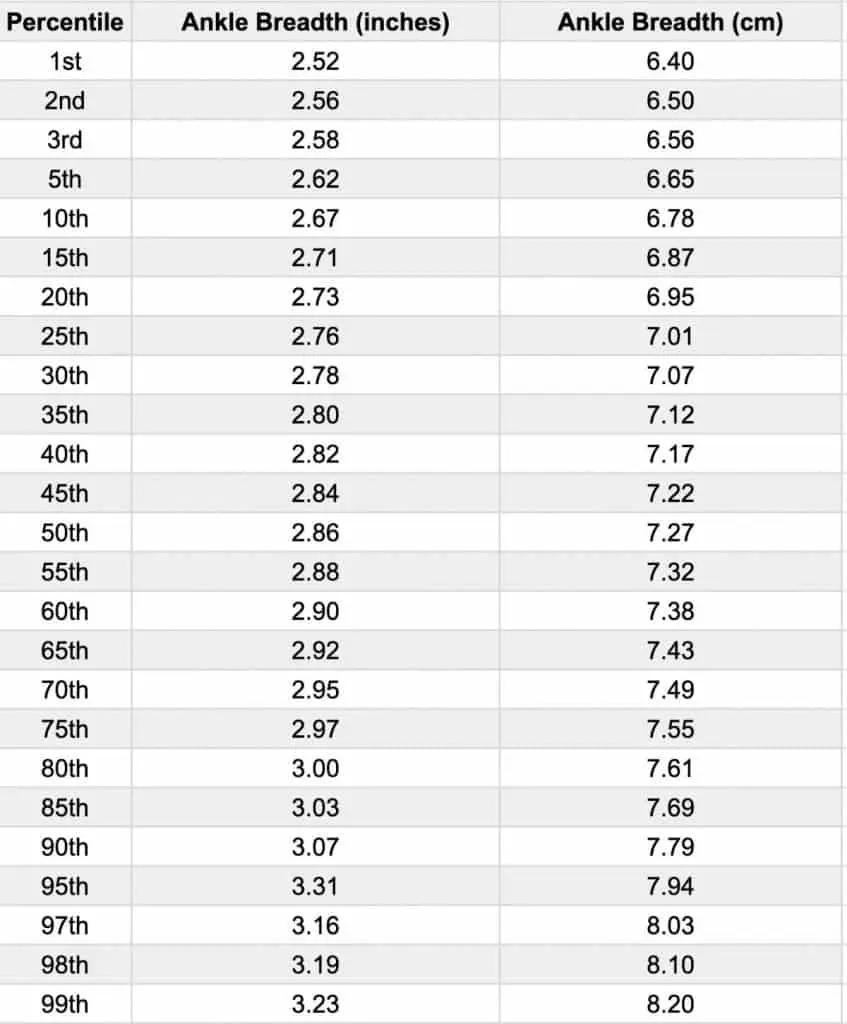
What is the average ankle width for men? According to the data, the average ankle breadth for adult males is 2.87 inches or 7.28 cm.
The anthropometric term for ankle width is bimalleolar breadth, a measurement that’s taken by measuring the distance between each malleolus, which is the bony part of the ankle.
Unlike ankle circumference, bimalleolar breadth is less prone to deviation because most people don’t store any fat directly on their ankle bones.
Rather, they store their fat above the ankle joint and below the calf, hence the term “cankle,” which refers to a lack of taper from the calf muscle to the ankle joint.
Female ankle size chart
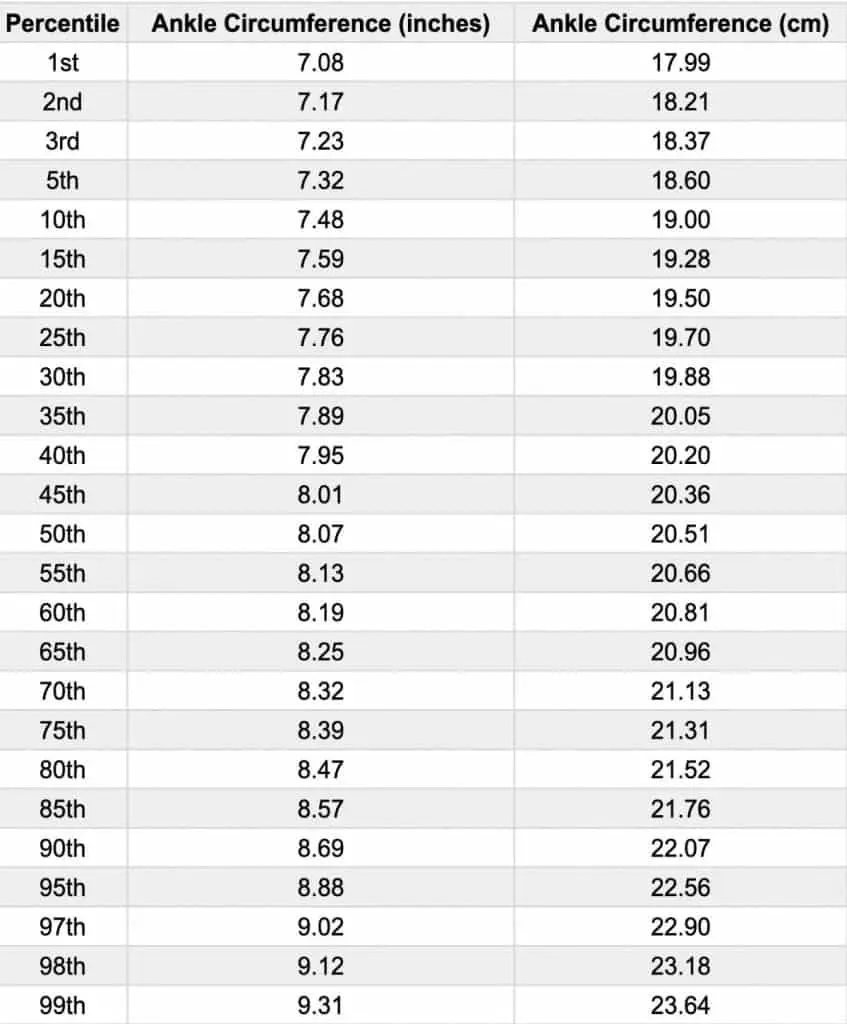
As you can see on the female ankle size chart above, women’s ankle circumference can vary by over 2 inches, which may be because of differences in body fat, bone structure, or both.
On average, women also tend to have a smaller ankle measurement than men. For example, women in the 99th percentile of ankle size have an equivalent ankle circumference measurement to men in the 85th and 90th percentile.
You might point out that this isn’t a huge difference, and you’d be right. But you also need to understand that an ankle circumference measurement takes into account body fat, whereas an ankle width measurement does not.
Since women typically have more body fat than men—especially on their lower bodies—this natural fat storage difference can often result in similar body part measurements between the sexes for areas of the body that store minimal fat and muscle.
In other words, if a man and a woman both have the same ankle size, then more of the man’s ankle circumference is likely to consist of bone, whereas more of the woman’s circumference is likely to consist of fat.
Male ankle measurement chart
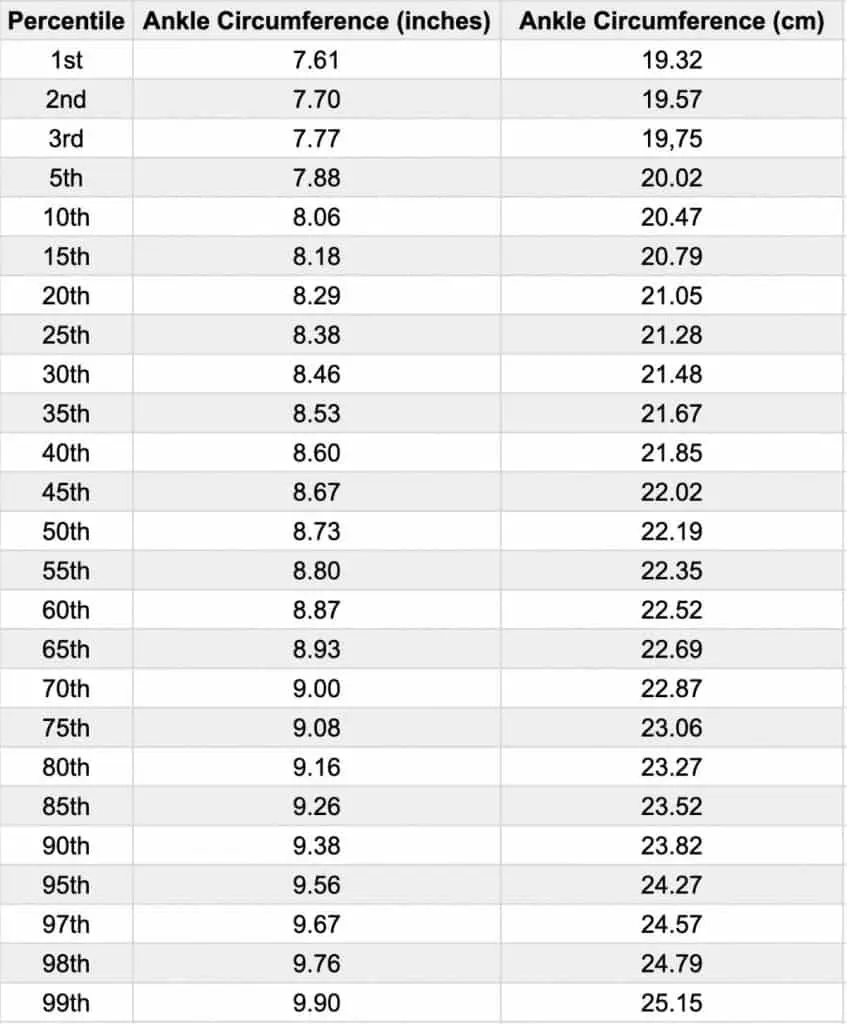
As with female ankle size, male ankle size also varies by over two inches. In this particular study—which examined nearly 2,000 men—the smallest ankle measurement was 7.61 inches, whereas the largest was 9.9 inches.
The above male ankle circumference chart shows that even within a specific group (in this case, US military personnel), there’s a significant variation in ankle size. This is simply because some men have much bigger and smaller frames than others.
Still, a 2-inch difference between people of the same gender and group is very large, considering how small the ankle is in comparison with other body parts.
How to measure your ankle size

If you want to learn how to measure your ankle size as accurately as possible—whether for an anklet, to determine your frame size, or just to see if you have a normal ankle size—then this guide is for you.
You’ll learn how to measure ankle circumference and ankle width so that you can understand just how big (or small) your ankles really are.
How to measure your ankle circumference

Measuring your ankle circumference is as simple as standing up and wrapping a flexible tape measure around the narrowest part of your ankle, which is often an inch or so above your ankle bone.
To make things even easier—and to ensure the most accurate reading—you can also get someone to measure your ankle size. With that said, here’s how to measure your ankle circumference with a tape measure.
- Stand up straight with your feet shoulder-width apart and your weight distributed evenly between both feet.
- Wrap a flexible tape measure around the narrowest part of your ankle.
- Keep the tape snug to your skin but don’t actively dig it into your flesh in an attempt to artificially reduce your ankle measurement.
- Observe where the ends of the tape overlap; that’s your ankle girth measurement.
- Take another 1-2 measurements to verify your true ankle size.
How to measure your ankle width
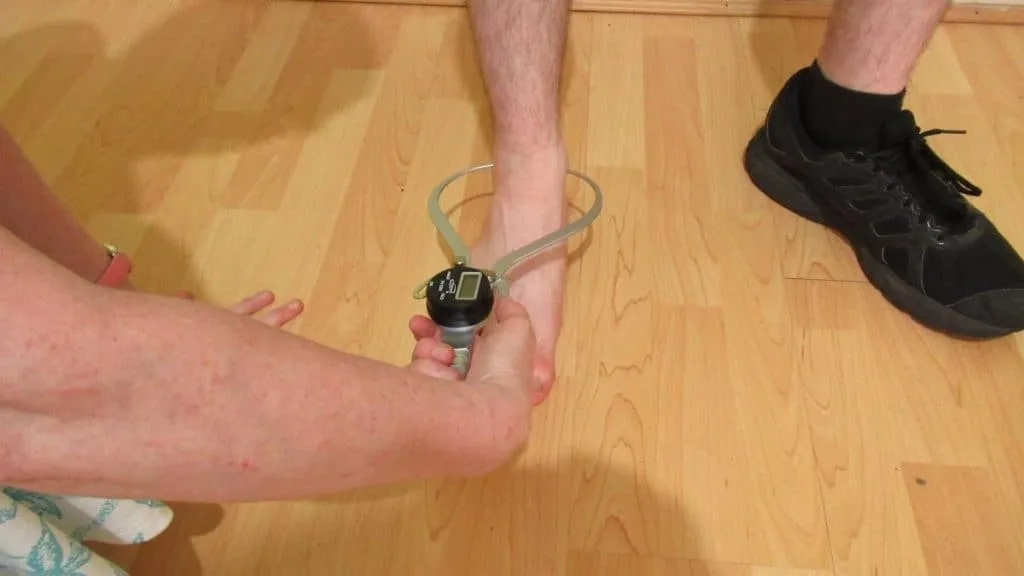
To take an accurate ankle width measurement, you’ll need to use a small spreading caliper, which is also called a breadth caliper.
Essentially, you want to measure between the medial and lateral malleoli on your ankle, which is to say you want to measure the distance between the protrusions on your ankle bones.
- Stand up straight with your feet shoulder-width apart.
- Have someone place the arms of a spreading caliper on each of your ankle bones (at the points where the bony part of your ankles protrude the most).
- Measure both of your ankles this way and record your measurements.
- Take another 1-2 measurements for each ankle to verify your accuracy.
How to measure your ankle size without a measuring tape
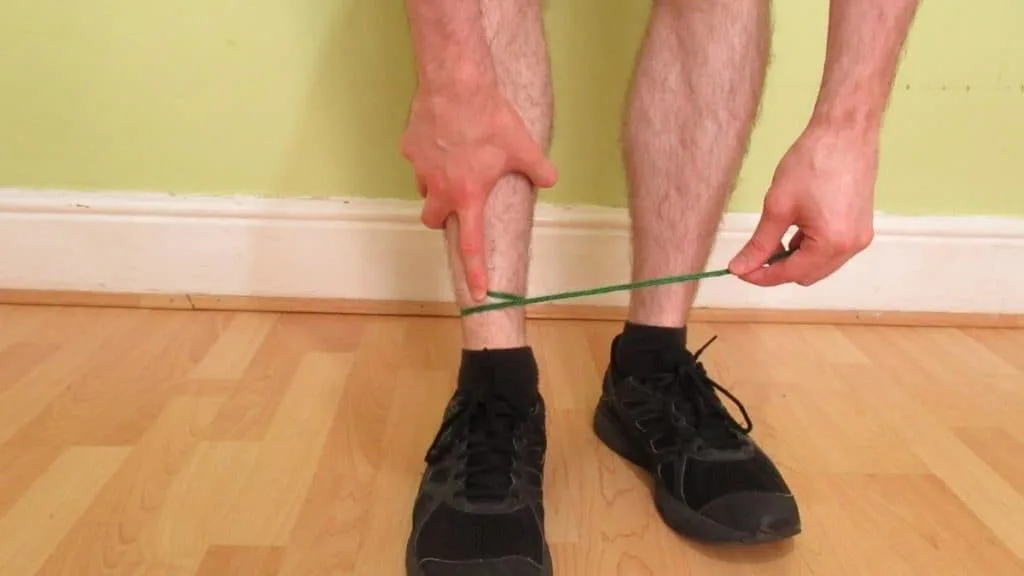
How can you measure your ankle size without a tape measure? There are two main ways to measure your ankle size without a measuring tape.
The first option is to wrap a piece of string around the narrowest part of your ankle and then mark where the ends overlap. From there, you just measure between the two points using a ruler.
The second option is similar but slightly more accessible—instead of using a piece of string, you’ll be using a thin strip of paper.
Simply cut a thin strip of paper off a regular sheet of paper and wrap it around your ankle as if it were a tape measure. Then, mark where the two ends overlap.
Finally, lay the paper flat and measure between the two points using a ruler to get your ankle circumference measurement.
Where should you measure your ankle?
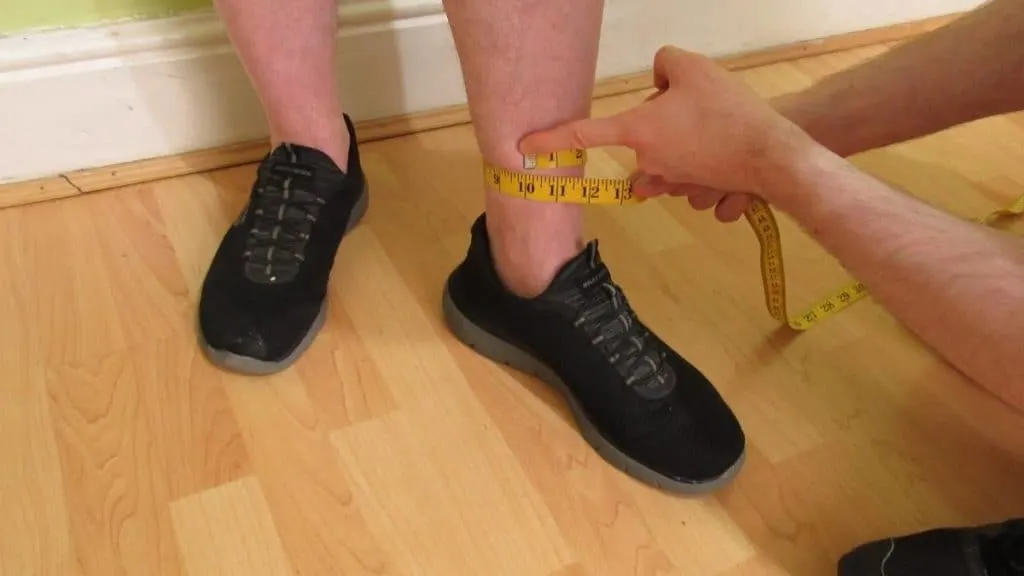
Where should you measure your ankle? To get the most accurate ankle girth measurement possible, you should measure around the narrowest part of your ankle, which is usually just above your ankle bone (your malleolus).
Some people recommend measuring around the bony parts of your ankle since this area stores less body fat. However, you’ll find that because the ankle bones protrude out, measuring your ankle this way results in a larger circumference measurement.
And anyway, if you want to measure the width of your ankle bones, you can take a bimalleolar breadth measurement, which I explained above.
How does your ankle measurement affect your frame size?

A 1993 study published in the Journal of Sports Sciences showed that ankle circumference was one of the strongest predictors of frame size. [5]
As such, it’s important that you take an accurate ankle circumference measurement so that you can determine your muscular potential (bigger bones can hold more muscle mass).
Of course, excess body fat can obscure your true circumference measurements. So you might want to measure other body parts if you’re really trying to determine your actual frame size.
Interestingly, there’s a much bigger male-female size difference in ankle width than in ankle circumference.
This is very likely because an ankle girth measurement takes into account body fat, whereas bimalleolar breadth is literally just a measurement of the width of your ankle bones, which hold virtually zero body fat.
Conclusion: Is there such a thing as an ideal ankle size?
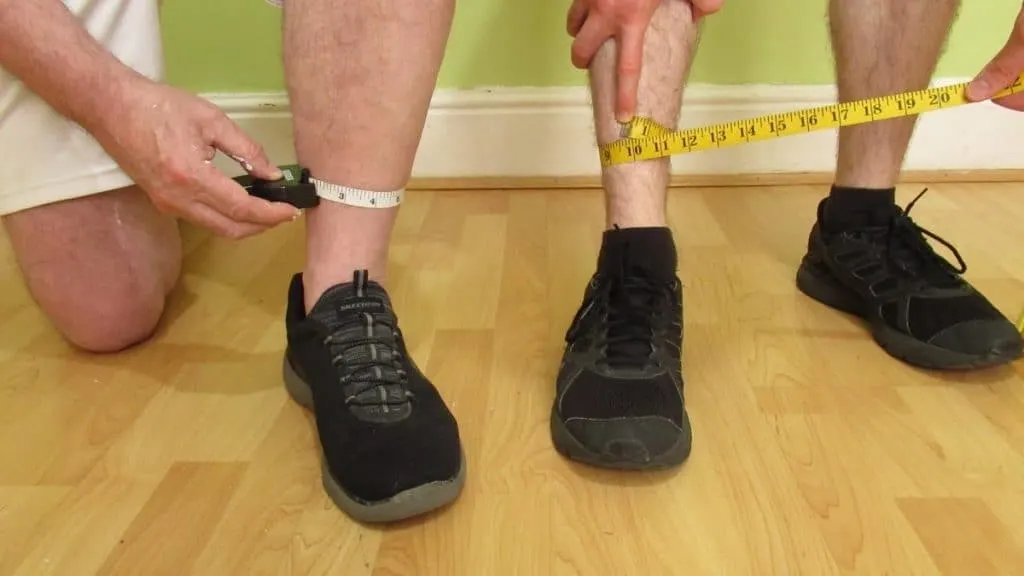
You now know the average ankle size in inches for both men and women. You also know how to measure ankle size in terms of both circumference and width. So, with that in mind, is there actually such a thing as the ideal ankle size for females and males?
Since the vast majority of your ankle circumference is determined by the size of your ankle bones, there isn’t one ideal ankle size or normal ankle circumference that every woman and man should aim for, seeing as we all have different builds and bone structures.
That said, if your measurement is in line with the average ankle size for your gender (around 8 inches for women and 9 inches for men), then you could consider that ideal.
Still, a lot of healthy people tend to store body fat above their ankles, which certainly increases their measurement beyond these averages. So as I’m fond of saying, don’t base your health and body image on one circumference measurement!
References
- GORDON, C. L. A. I. R. E. C., CHURCHILL, T. H. O. M. A. S., CLAUSER, C. H. A. R. L. E. S. E., BRADTMILLER, B. R. U. C. E., McCONVILLE, J. O. H. N. T., TEBBETTS, I. L. S. E., & WALKER, R. O. B. E. R. T. A. (1989, September). 1988 ANTHROPOMETRIC SURVEY OF U.S. ARMY PERSONNEL: METHODS AND SUMMARY STATISTICS. UNITED STATES ARMY NATICK RESEARCH, DEVELOPMENT AND ENGINEERING CENTER NATICK, MASSACHUSETTS. http://tools.openlab.psu.edu/publicData/ANSUR-TR89-044.pdf
- Karakaş, P., & Bozkir, M. G. (2007). Determination of Normal Calf and Ankle Values Among Medical Students. Aesthetic Plastic Surgery, 31(2), 179–182. https://doi.org/10.1007/s00266-006-0132-6
- M.White, R. (1982, December). COMPARATIVE ANTHROPOMETRY OF THE FOOT. U.S. Army Natick Research & Development Laboratories. https://apps.dtic.mil/sti/pdfs/ADA126189.pdf
- Yamaner, F., Karacabey, K., Kavlak, Y., & Sevindi, T. (2011). Foot morphology of Turkish football players according to foot preference. African Journal of Biotechnology, 10(26). https://www.ajol.info/index.php/ajb/article/view/94255
- Peters, D. M., & Eston, R. (1993). Prediction and measurement of frame size in young adult males. Journal of sports sciences, 11(1), 9–15. https://doi.org/10.1080/02640419308729957

